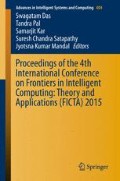Abstract
Post-translational modification is the attachment of biochemical functional groups after translation from mRNA. Among the different post translational modifications, phosphorylation happens to be one of the most important types which is responsible for important cellular operations. In this research work, we have used multilayer perceptron (MLP) to predict protein residues which are phosphorylated. As features, we have used position-specific scoring matrices (PSSM) generated by PSI-BLAST algorithm for each protein sequence after three runs against 90 % redundancy reduced Uniprot database. For an independent set of 141 proteins, our system was able to provide the best AUC score for 36 proteins, highest for any other predictor. Our system achieved an AUC score of 0.7239 for all the protein sequences combined, which is comparable to the state-of-the art predictors.
Access this chapter
Tax calculation will be finalised at checkout
Purchases are for personal use only
References
Trost, B., Kusalik, A.: Computational prediction of eukaryotic phosphorylation sites (2011)
Basu, S., Plewczynski, D.: AMS 3.0: prediction of post-translational modifications. BMC Bioinform. 11, 210 (2010)
Plewczynski, D., Basu, S., Saha, I.: AMS 4.0: consensus prediction of post-translational modifications in protein sequences. Amino Acids 43, 573–582 (2012)
Puntervoll, P., Linding, R., Gemünd, C., Chabanis-Davidson, S., Mattingsdal, M., Cameron, S., Martin, D.M.A., Ausiello, G., Brannetti, B., Costantini, A., Ferrè, F., Maselli, V., Via, A., Cesareni, G., Diella, F., Superti-Furga, G., Wyrwicz, L., Ramu, C., McGuigan, C., Gudavalli, R., Letunic, I., Bork, P., Rychlewski, L., Küster, B., Helmer-Citterich, M., Hunter, W.N., Aasland, R., Gibson, T.J.: ELM server: a new resource for investigating short functional sites in modular eukaryotic proteins. Nucleic Acids Res. 31, 3625–3630 (2003)
Dou, Y., Yao, B., Zhang, C.: PhosphoSVM: prediction of phosphorylation sites by integrating various protein sequence attributes with a support vector machine. Amino Acids 46, 1459–1469 (2014)
Kim, J.H., Lee, J., Oh, B., Kimm, K., Koh, I.: Prediction of phosphorylation sites using SVMs. Bioinformatics 20, 3179–3184 (2004)
Blom, N., Gammeltoft, S., Brunak, S.: Sequence and structure-based prediction of eukaryotic protein phosphorylation sites. J. Mol. Biol. 294, 1351–1362 (1999)
Hjerrild, M., Stensballe, A., Rasmussen, T.E., Kofoed, C.B., Blom, N., Sicheritz-Ponten, T., Larsen, M.R., Brunak, S., Jensen, O.N., Ganuneltoft, S.: Identification of phosphorylation sites in protein kinase A substrates using artificial neural networks and mass spectrometry. J. Proteome Res. 3, 426–433 (2004)
Huang, Y., Niu, B., Gao, Y., Fu, L., Li, W.: CD-HIT suite: a web server for clustering and comparing biological sequences. Bioinformatics 26, 680–682 (2010)
Biswas, A.K., Noman, N., Sikder, A.R.: Machine learning approach to predict protein phosphorylation sites by incorporating evolutionary information. BMC Bioinform. 11, 273 (2010)
Xue, Y., Gao, X., Cao, J., Liu, Z., Jin, C., Wen, L., Yao, X., Ren, J.: A summary of computational resources for protein phosphorylation. Curr. Protein Pept. Sci. 11, 485–496 (2010)
Xue, Y., Ren, J., Gao, X., Jin, C., Wen, L., Yao, X.: GPS 2.0, a tool to predict kinase-specific phosphorylation sites in hierarchy. Mol. Cell. Proteomics 7, 1598–1608 (2008)
Gao, J., Thelen, J.J., Dunker, A.K., Xu, D.: Musite, a tool for global prediction of general and kinase-specific phosphorylation sites. Mol. Cell. Proteomics 9, 2586–2600 (2010)
Trost, B., Kusalik, A.: Computational phosphorylation site prediction in plants using random forests and organism-specific instance weights. Bioinformatics btt031 (2013)
Banerjee, S., Basu, S., Nasipuri, M.: Big data analytics and its prospects in computational proteomics. In: Information Systems Design and Intelligent Applications. pp. 591–598. Springer, Berlin (2015)
Acknowledgments
Authors are indebted to CMATER, department of computer science and Engineering, Jadavpur University for providing the necessary support for carrying out this experiment.
Author information
Authors and Affiliations
Corresponding author
Editor information
Editors and Affiliations
Rights and permissions
Copyright information
© 2016 Springer India
About this paper
Cite this paper
Banerjee, S., Ghosh, D., Basu, S., Nasipuri, M. (2016). JUPred_MLP: Prediction of Phosphorylation Sites Using a Consensus of MLP Classifiers. In: Das, S., Pal, T., Kar, S., Satapathy, S., Mandal, J. (eds) Proceedings of the 4th International Conference on Frontiers in Intelligent Computing: Theory and Applications (FICTA) 2015. Advances in Intelligent Systems and Computing, vol 404. Springer, New Delhi. https://doi.org/10.1007/978-81-322-2695-6_4
Download citation
DOI: https://doi.org/10.1007/978-81-322-2695-6_4
Published:
Publisher Name: Springer, New Delhi
Print ISBN: 978-81-322-2693-2
Online ISBN: 978-81-322-2695-6
eBook Packages: EngineeringEngineering (R0)

